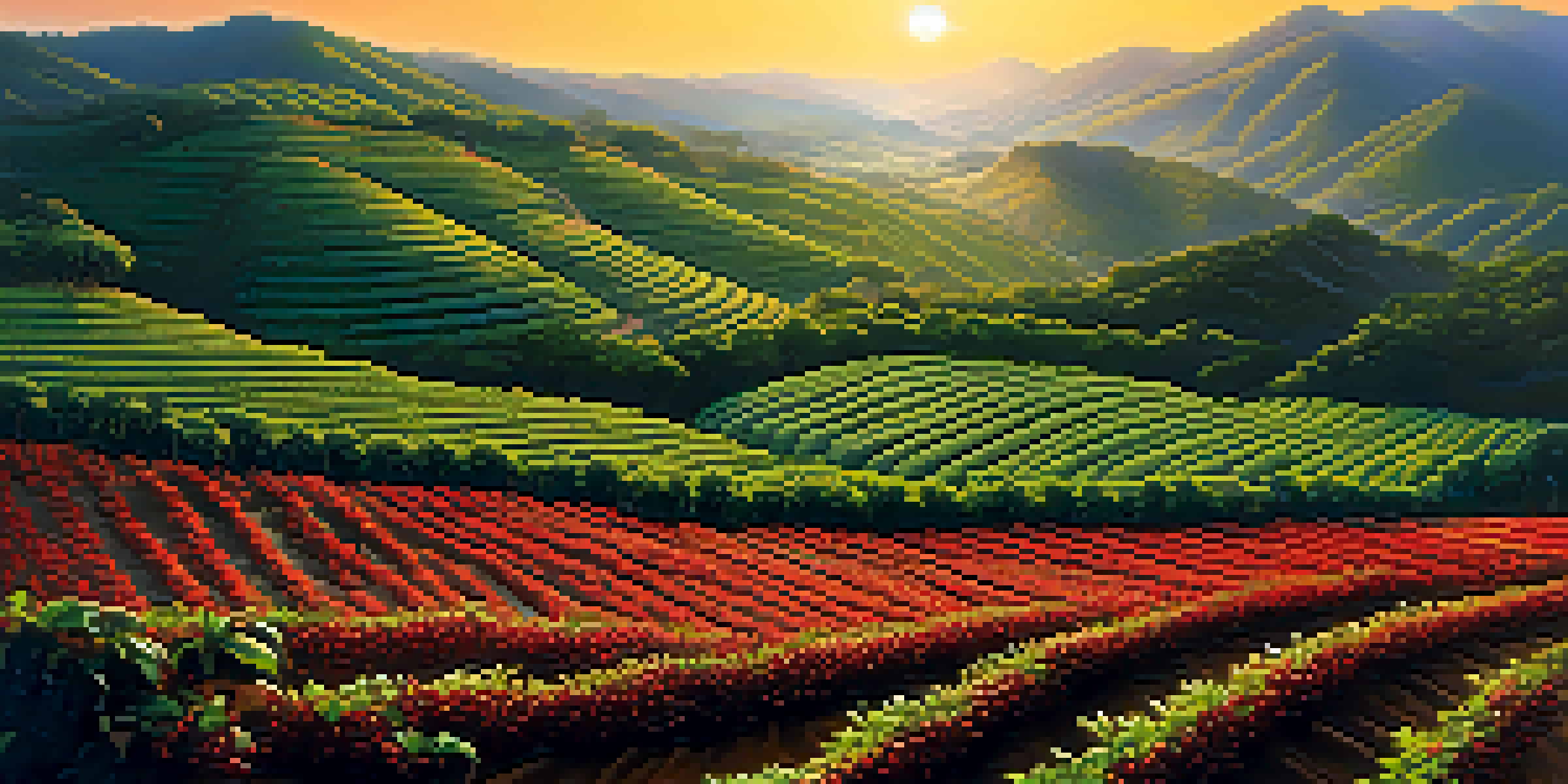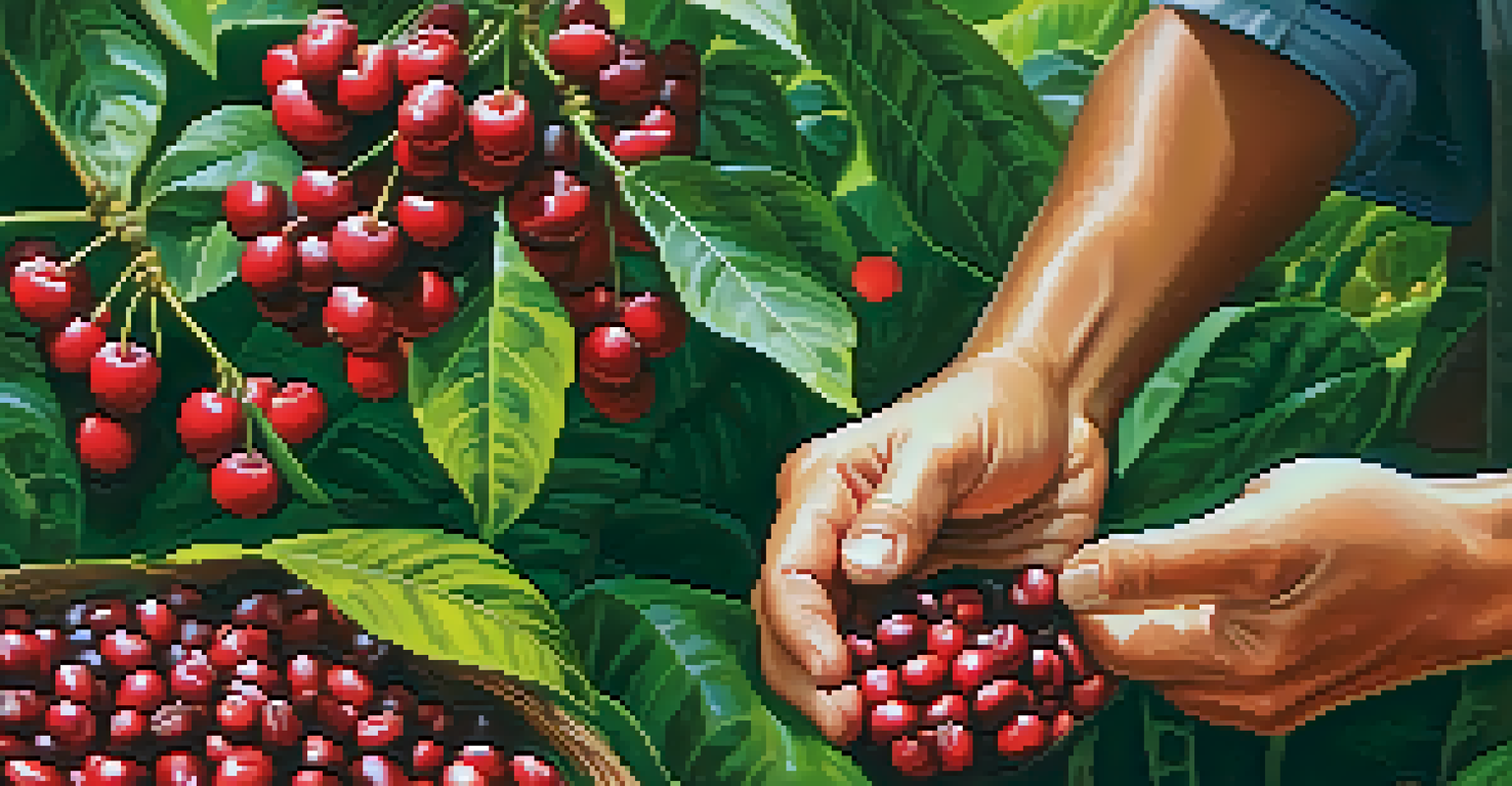Exploring the Coffee-Making Process at Brazilian Farms

The Rich History of Coffee in Brazil
Brazil has a storied history with coffee that dates back to the 18th century. Initially introduced by Portuguese settlers, the crop quickly flourished due to the country's ideal climate and soil conditions. Today, Brazil stands as the world's largest coffee producer, contributing about a third of the coffee consumed globally.
Coffee is a language in itself.
The journey of this beloved beverage begins with its cultivation on sprawling plantations, often nestled in picturesque landscapes. These farms not only produce coffee but also embody the traditions and culture of the Brazilian people. Understanding this rich history adds depth to our appreciation of every cup we enjoy.
As we explore the coffee-making process, it’s fascinating to see how deeply intertwined coffee is with Brazil's identity, economy, and daily life. Each bean carries with it stories of the land, the laborers, and the love poured into its cultivation.
Cultivation: From Seed to Sapling
Coffee cultivation begins with selecting the right coffee variety, often choosing between Arabica and Robusta. Arabica beans are known for their sweet, soft flavors, while Robusta is stronger and more bitter. Farmers typically plant seeds in nurseries, where they germinate and grow into young saplings.

Once the saplings reach a suitable height, they are transplanted into the fields, where they will thrive for several years. Brazilian farmers carefully consider factors such as altitude, climate, and soil quality, all crucial for the health of the coffee plants. This meticulous planning ensures that the coffee trees can produce high-quality beans.
Brazil's Coffee Legacy
Brazil has a rich coffee history, becoming the world's largest producer due to its ideal growing conditions.
During this growth phase, farmers often employ sustainable practices, such as shade-grown techniques, which protect the plants and the environment alike. This commitment to sustainability not only benefits the coffee but also preserves the rich biodiversity of Brazil's landscapes.
The Harvesting Process: A Labor of Love
Harvesting coffee is an intensive process that usually occurs once a year, typically between May and September in Brazil. Farmers face the choice of hand-picking or using mechanical harvesters. Hand-picking is labor-intensive but allows for selective harvesting of only the ripest cherries, ensuring the highest quality.
Life is too short for bad coffee.
The peak harvesting season transforms the farms into bustling hubs of activity. Workers, often from local communities, come together to collect the cherries at dawn, their baskets filling with bright red fruit. This communal effort not only strengthens ties among workers but also celebrates the rich tradition of coffee farming.
Once harvested, the cherries must be processed quickly to prevent spoilage. This urgency adds a layer of excitement to the harvest, as every moment counts in ensuring the beans' flavor and quality are preserved for the journey ahead.
Processing Coffee: Methods and Techniques
After harvesting, the next crucial step is processing the coffee cherries. There are primarily two methods: the dry method and the wet method. The dry method involves spreading the cherries out in the sun to dry, while the wet method requires removing the cherry’s outer pulp before fermenting and washing the beans.
Each method imparts different flavor profiles to the coffee, making this step vital for the final product. Brazilian farms often use a combination of both methods, leveraging their unique climate conditions to enhance the beans' flavors. The choice of processing technique can greatly influence the overall taste of the coffee we enjoy.
Sustainable Farming Practices
Brazilian farmers are increasingly adopting sustainable methods to enhance coffee quality and protect the environment.
Processing can take several days to weeks, depending on the method chosen. During this time, the beans are monitored closely to ensure they dry evenly, which is crucial for preventing mold and maintaining quality.
Drying and Milling: Preparing for Export
Once processed, the coffee beans must be dried to an optimal moisture level, usually around 10-12%. This is crucial because excess moisture can lead to spoilage during storage and transport. Brazilian farms often utilize solar drying methods, taking advantage of the country's abundant sunlight.
After drying, the beans are hulled to remove any remaining parchment layer, followed by grading and sorting based on size and weight. This meticulous attention to detail ensures that only the best beans make it to market. Quality control at this stage is paramount, as it impacts everything from pricing to consumer satisfaction.
The final step before export involves packaging the beans in burlap or jute bags, ready to embark on their journey around the world. This often marks the end of a long process, but for farmers, it’s just the beginning of a new adventure as their coffee makes its way to eager consumers.
Tasting and Enjoying Brazilian Coffee
Once the coffee arrives at roasters and cafes, the real magic happens. Tasting Brazilian coffee is an experience in itself, as these beans are known for their rich, chocolatey flavors and nutty undertones. Coffee aficionados often describe the taste as smooth and well-balanced, making it a favorite among many.
Baristas and roasters experiment with different brewing methods, from espresso to pour-over, to highlight the unique characteristics of Brazilian coffee. Each method brings out different flavors, allowing consumers to appreciate the nuances of the beans. This versatility is part of what makes Brazilian coffee so beloved worldwide.
Future Challenges and Innovations
Coffee farmers in Brazil are facing climate change challenges while leveraging technology and transparency to thrive.
For those new to Brazilian coffee, a simple cup brewed with care can provide a delightful introduction. As you sip, consider the journey these beans took from the farm to your cup—a story of hard work, dedication, and a passion for quality.
The Future of Coffee Farming in Brazil
Looking ahead, Brazilian coffee farmers face both challenges and opportunities. Climate change poses a significant threat, altering weather patterns and affecting crop yields. However, many farmers are adapting by implementing sustainable farming practices and diversifying their crops to ensure resilience.
Technological advancements also play a role in the future of coffee farming. Innovations such as precision agriculture and data analytics are helping farmers optimize their practices, leading to higher quality beans and more efficient operations. These changes not only benefit the farmers but also the environment.

As consumers become more aware of the origins of their coffee, there is a growing demand for ethically sourced beans. Brazilian farms are responding by emphasizing transparency in their practices, allowing consumers to connect with the journey of their coffee. This shift towards sustainability and quality is paving the way for a brighter future for Brazilian coffee.